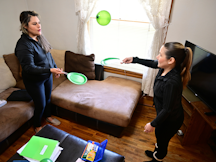PUEBLO, Colorado — Standing in her living room, Isabel Valencia sets up her makeshift tennis serve with the materials on hand: a green balloon for a ball and a ruler affixed to a paper plate for a racket.
She bats the balloon to her home visitor, Mayra Ocampo, and they pass it back and forth, counting each return, offering encouragement and laughing at their mistakes.
The moment is light and playful, as it likely will be later in the week, when Valencia tries the same activity with her 4-year-old daughter Celeste. But Ocampo takes care to explain what’s happening beneath the surface: They’re not just playing tennis. They’re building social skills. They’re working on hand-eye coordination. And they’re practicing numeracy.

Valencia, who came to the U.S. from Colombia a few years ago, found Ocampo through a free home visiting program that supports families with their children’s early learning and development.
The model — and others like it — has provided a lifeline for families, especially those for whom access to quality early education is scarce or out of reach financially. These programs, which are set to expand with new federal support, are proven to help prepare children for school but have reached relatively few families.
It was during a trip to the grocery store in 2022 with her two young kids that somebody told Valencia about the home visiting program. She had moved to Pueblo, Colorado, only a few months earlier and was feeling isolated. She hadn’t met anyone else who spoke Spanish.
“I didn’t leave my house,” she says through an interpreter, “so I thought I was the only one.”
The Home Instruction for Parents of Preschool Youngsters program, known as HIPPY, provides families with a trained support person — in Valencia’s case, Ocampo — who visits their home every week, showing them how to engage their children with fun, high-quality, developmentally appropriate activities.
The HIPPY program is unique for its two-generation approach. Through regular home visits and monthly group meetings, parents learn how to promote early literacy and social-emotional skills from staff who went through the program themselves and often share the same language and background as the families they serve.
The program is primarily implemented in low-income neighborhoods, as well as through school districts and organizations reaching immigrant and refugee families, says Miriam Westheimer, chief program officer for HIPPY International, which operates in 15 countries and 20 U.S. states.
Many other home visiting models exist, each with distinct features. Some employ registered nurses as home visitors, focusing on maternal and child health; others send social workers or early childhood specialists. They can begin as early as pregnancy or, as in the case of HIPPY, serve families with toddlers and preschool-aged children.
In the U.S., two dozen home visiting models have received a stamp of approval — and with it, access to funding — from the federal government’s Maternal, Infant and Early Childhood Home Visiting (MIECHV) program.
Dr. Michael Warren, associate administrator of the Maternal and Child Health Bureau at the Health Resources and Services Administration, which oversees the MIECHV program, has seen first-hand the way home visiting can strengthen families but says that, right now, its scope is too limited.
An estimated 17 million families nationwide stand to benefit from the type of voluntary, evidence-based home visiting services that Valencia receives. Yet in 2022, only about 270,000 did.
“That is purely because of resources,” notes Warren. “If more resources exist, more families can be served.”
Fortunately, he says, reinforcements are on the way.
The federal investment in the MIECHV program is set to double from $400 million to $800 million annually, by 2027. Beginning this year, the federal government will match $3 for every $1 in non-federal funds spent on home visiting programs, up to a certain amount. Since many states already have funding mechanisms in place — through a combination of public, nonprofit and private contributions — it is expected to be an easy win.
In interviews with more than 20 individuals who conduct, receive or research home visits, and in observation of two home visits in Colorado and Texas, the extent of this service’s impact on families and communities became clear.
Now in her second year of the HIPPY program, Valencia is a more confident parent. She says the structured curriculum she follows, paired with Ocampo’s support, have helped her prepare her daughter to thrive in preschool.
- SEO Powered Content & PR Distribution. Get Amplified Today.
- PlatoData.Network Vertical Generative Ai. Empower Yourself. Access Here.
- PlatoAiStream. Web3 Intelligence. Knowledge Amplified. Access Here.
- PlatoESG. Carbon, CleanTech, Energy, Environment, Solar, Waste Management. Access Here.
- PlatoHealth. Biotech and Clinical Trials Intelligence. Access Here.
- Source: https://www.edsurge.com/news/2024-05-29-many-lack-access-to-quality-early-education-home-visiting-programs-are-bringing-it-to-more-families



